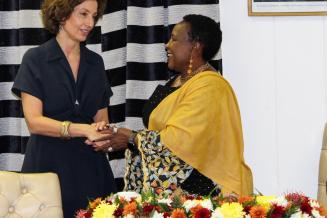News
昆仑镇罗伞岭何时 开播 央视公益地面波 数字电视

During her visit, the Director-General toured two World Heritage sites: the Great Zimbabwe National Monument and the Victoria Falls-Mosi-oa-Tunya site. These visits served to highlight the interdependence between heritage conservation, ecosystem protection, and local development, particularly in light of the global call to “Protect Wetlands for Our Common Future.”
Located approximately 500 km southeast of Victoria Falls, the Great Zimbabwe National Monument is one of the most iconic archaeological sites on the African continent. Between 2022 and 2024, UNESCO partnered with Zimbabwe’s Ministry of Home Affairs and Cultural Heritage to revise the site’s management plan, train staff, and establish a new cultural hub. This hub connects the monumental ruins to the intangible Shona cultural heritage, providing a dynamic platform for education, tourism, and community engagement.
The initiative pursues two primary objectives: first, to mitigate erosion risks threatening the stone structures dated from the 11th to 15th centuries; and second, to ensure that tourism-generated revenue supports the socio-economic development of nearby communities. This integrated approach reflects the Ramsar Convention’s vision that healthy wetlands and thriving cultural landscapes are mutually reinforcing.

Empowering rural areas through Renewable Energy
UNESCO also supports science-based wetland management, including the BuPuSa early warning system—funded by Austria—which enables Zimbabwe and Mozambique to share real-time flood data. Complementary programmes such as Be RESILIENT are helping farmers adapt through groundwater harvesting, drought-resistant crops, and local climate finance. ?These interventions expand on lessons learned after Cyclone?Idai, when UNESCO worked with the World?Bank to restore basic services for more than 440,000 people.
Under Zimbabwe’s Agriculture?6.0 strategy, UNESCO, UN?Women, UNDP and UNCDF have helped treble the Renewable Energy Fund (ZimREF) to?US$45?million. Women-led solar installations and off-grid mini-grids are helping reduce pressure on wetlands while advancing rural electrification.
Education threads through each pillar
A new heritage-based curriculum, aligned with UNESCO’s cultural education framework, is also being piloted—offering students tools to understand the link between heritage, ecosystems, and climate action. These educational elements will feature prominently in COP15 outreach activities.
Together, these efforts offer a replicable model for leveraging heritage and ecosystems as assets for a climate-resilient future.









